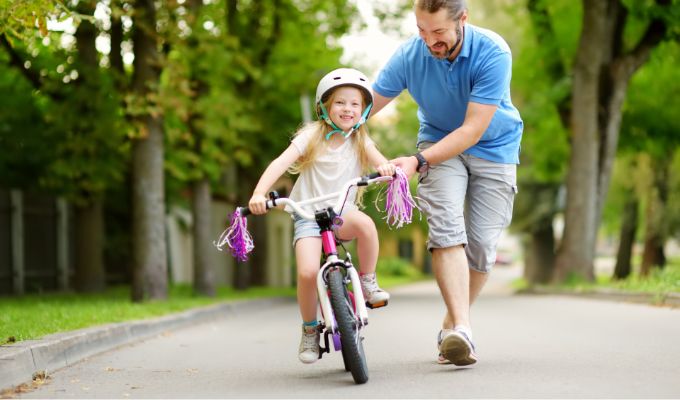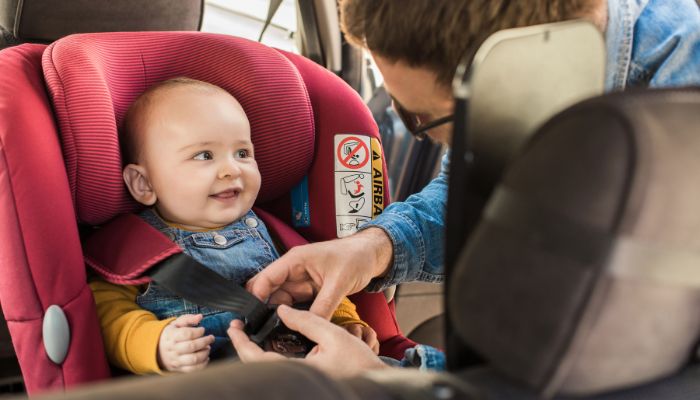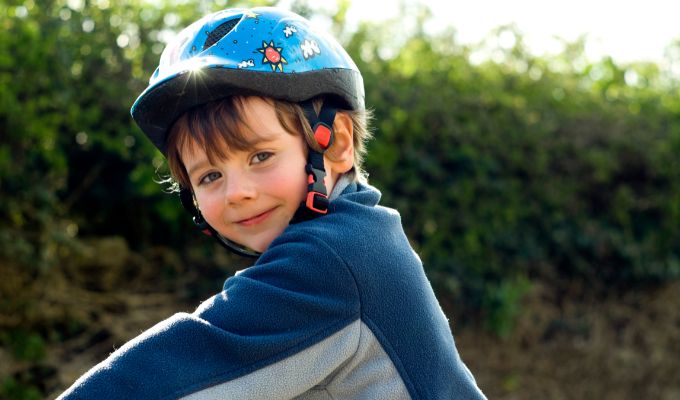Once a child’s motor skills have developed and he or she has the will to ride, there is no stopping them from getting on a two-wheeler. But the hard part is learning to ride without causing injury. Those first wobbly peddles are nerve-racking, but as they say, learning to ride a bike is something you never forget.
Many children have a special affinity for cycling. Because if you can pedal, you’re among the elite, you’re in the cool kids club.
As a parent, teaching your child to ride independently is one of that happy forever moments that fills you with pride. But when is your child truly ready to ride a bike, and what is the most effective method for teaching them?
What Age Should Kids Start Cycling?
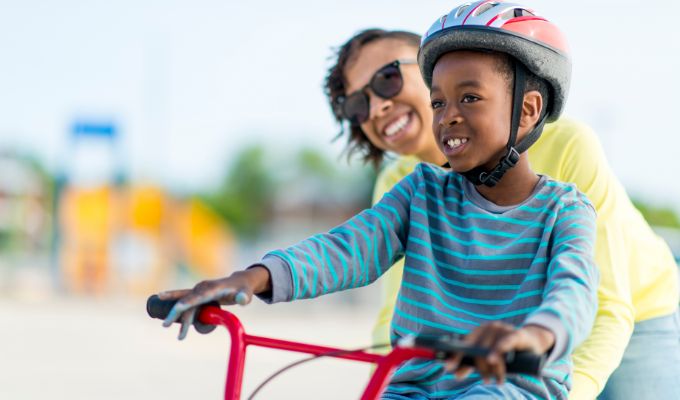
Obviously, there is no minimum age for a youngster to be able to ride a bicycle. Every child develops at his or her own rate, as is true in every other aspect of life. In recent years, however, children have been spotted mounting and dismounting their bicycles sooner and earlier.
Some eager 3-year-olds children can already cycle independently. The child’s motor skills and body awareness are crucial to his or her success in learning to ride a bicycle.
Due to the fact that many children today are already out and about with a balance bike by the age of one or two, they learn to maintain their balance and steer a bicycle at a young age. This builds the groundwork for future cycling and makes the move to a bike with pedals much simpler.
Obviously, there are also children who develop an interest in riding or motor skills later in life. Of course, that’s acceptable as well. By the time school begins, the vast majority of children are proficient cyclists.
Star With a Balance Bike
Riding a scooter or balance bike helps toddlers develop their sense of balance, quick thinking, and coordination, which is fantastic practice for learning to ride a “big bike”. A four-wheeled balance bike can be used by young children as young as one who can walk.
Your child will have solid cycling motor skills once they are comfortable riding with one or both buddies. All that is now lacking is a clear desire to learn how to ride a bicycle. Nothing will then stand in the way of your child’s first practice rides on the bike, and they will have the necessary incentive to overcome minor setbacks and failures more readily without losing interest in biking.
The best bicycle to Teach a Chil
Having the proper tools is crucial to your success when learning to ride a bicycle. Not only does your child’s bike need to be the proper size for them, but the right accessories, such as a helmet and bell, can also make cycling more enjoyable. When purchasing a bike, bear the following in mind:
The smallest kids’ bikes start at 12 inches in length. As a result, kids who are 95 cm or taller at the daycare centre can already drive. The bike is too big if your child can’t stand with their feet on the ground. The phrase “You’ll grow into it,” which is common among parents, is appropriate for apparel but not for bicycles.
While the majority of primary school pupils are already riding bikes, older and larger children can start on a 16- to 18-inch bike. Your child will find it easier to hold a bike that is lightweight. But that doesn’t exclude kids from learning to ride a bike on slightly heavier, more durable bikes. In a specialised store, you can receive guidance on the ideal bike size and model.
Before you buy the bike, be sure to test it out with the child because not all models are suitable for all kids. The first child’s bike, in particular, will be heavily utilised and frequently tip over. It can only be ridden for a very brief period of time due to its small size and your children’s quick growth at this age.
Saddle and handlebars: When a child is sitting on a bicycle, the saddle should be set such that both of their feet can readily contact the ground, not just their toes. Your infant should be able to sit as upright as feasible and comfortably with the proper height adjustment of the handlebars.
Equipment: A closed chain guard is essential to prevent garment tangles from making your youngster fall. The handles should also be cushioned and secure.
A cushioned, curved handlebar should provide adequate impact protection. Naturally, the brakes must function as well. The majority of starter bikes come with a coaster brake. This is crucial for very young bikers because daycare kids frequently lack the hand strength needed to pull the handbrakes firmly enough. Additionally, a coaster brake usually allows children to react more quickly.
Pads and helmets: A helmet is required! You ought not to listen to anyone talk to you about this either. No biking without a helmet.
Allowing your child to choose their own helmet—one that, of course, the expert agrees fits them properly—will encourage them to actually use the head protection.
Provide your child with additional protective apparel, such as elbow and knee pads made specifically for children, if you want to be on the safe side. Children who are apprehensive in particular may feel more secure about the challenge of learning to ride a bike thanks to this added protection.
Do Kids Need Bike Stabilisers to Learn?
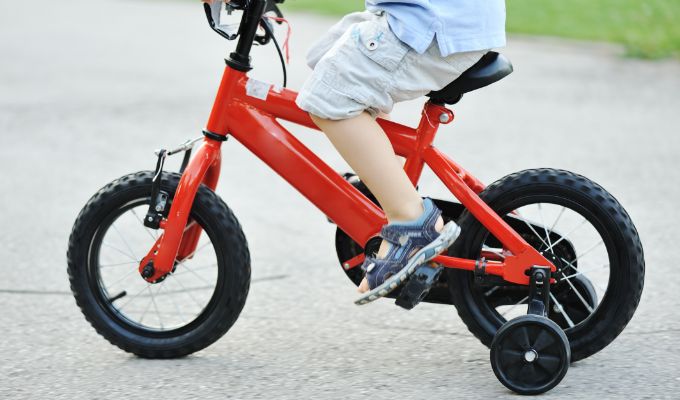
It was once typical to begin learning to ride a bike with training wheels. Most of our parents have most likely completed their first laps on training wheels. Experts now advise against using training wheels.
For kids who are currently safe on their balance bikes, using training wheels would be a step backwards. Because they are already capable of maintaining their balance while driving. Training wheels make learning to ride a bike more difficult, not easier.
Your child doesn’t have to maintain balance while driving, which conveys the incorrect driving feeling. Worst case scenario: Your youngster will lose the knowledge of balanced riding that they already possess.
Training wheels also offer your youngster the false impression that they cannot fall over, whether they are driving or standing. When the training wheels are removed, your youngster must re-learn how to feel for the bike and his own body while riding it.
Training wheels are thus an unneeded and unproductive intermediary step in learning to ride a bike.
If your child is still having problems retaining their balance, let them ride about on the balance bike or bicycle without the pedals for a while longer. This improves balance, and your youngster will be ready to try pedalling again shortly.
Places to Teach a Child to Ride a Bike
Obviously, we are all aware that our children should not learn to ride bicycles near or on a busy road. Here are sine safer suggestions…
Parks are excellent practice areas. However, you should choose a peaceful day or time of day, as other cyclists, dogs, and joggers may pose a threat to your young bikers (or vice versa).
Large private carparks after closing, when there are no longer any parked automobiles and no customers are driving in or out.
The garden: Those who are fortunate enough to have a sufficiently large yard or a level garden area can teach their children how to ride a bicycle with ease.
Fields or forest paths devoid of substantial pedestrian or cyclesits traffic are also ideal for training.
Grass or garden: It is easier to tumble on grassy, soft ground. However, uneven terrain might also contribute to this. You may also run afoul of park officials if you allow your children to play on the lush English lawns.
In general, any wider area with as few bumps, inclines, drops, obstructions, and traffic as possible is best for learning how to ride a bicycle for the first time.
Tips for parents who teach their children to cycle
Not only is learning to ride a bicycle difficult but teaching someone to do so has its own challenges. And as we all know from our time in school, a good instructor is frequently essential for academic advancement. Obviously, this also applies to parents teaching their children to ride a bicycle. The following are suggestions for the most enjoyable practice rounds for parents and children:
Patience: Try to maintain composure and patience at all times. Avoid creating pressure through explicit expectations or unfavourable comparisons. If your children are tired of learning bicycle riding, take a break or continue exercising the next day. If you are calm, your child will be calm, and eventually, the cycling will resolve itself.
Appropriate assistance: In the beginning, you may assist your child while driving by holding them by the shoulders or the back. However, you should remove your hands from the saddle and handlebars so that your youngster must maintain his own balance. Always keep your youngster facing forward when aiding, so they don’t turn around to view you while they’re practising. When cycling, your child should constantly glance ahead.
Don’t push too hard: Rather than pushing, encourage your child to pedal by pushing. Pushing can be passive. If you push your child, do not let go without a warning: the child could fall!
Dealing with falls: Don’t panic if you fall! As a general rule, child riders are slow-moving and have a short hall. A helmet will of course help protect your child’s head, but some mild falls come with the territory, so they should learn to fall. Typically, it is shock that causes your youngster to cry. When the tears have dried, it is possible to proceed.
Practice makes (almost) perfect: Once you have peddled a few metres securely and independently, you can practise driving on other surfaces, such as a meadow or cobblestones.
Starting and stopping are also problematic areas. To be able to stop swiftly and precisely in dangerous situations and when crossing the street in the future, this skill must be taught safely. Cycling should be included in daily life as much as possible, as only practice makes perfect.
Caution at Roads
Your child should only ride their bicycles on a public road after they have completed their school cycling proficiency course. Children under the age of 16 should ride on the pavement and are not permitted to ride on the road for safety concerns.
In addition to reflectors, lights, working brakes, a bell, and tyres that are always inflated, the following bicycle equipment is crucial in road traffic: reflectors, lights, working brakes, a bell, and tyres that are always inflated. Lastly, we would like to remind you that wearing a bicycle helmet saves lives in an emergency and prevents serious injuries.
Regardless of the bicycle your youngster rides. Regardless of whether your child likes to speed down steep forest slopes, do stunts in the park, or prefers to cycle comfortably, there are a few things that are needed for safe cycling: cool bike paths, a safety helmet, the proper bike size for your child, and of course a crack-proof lock.
